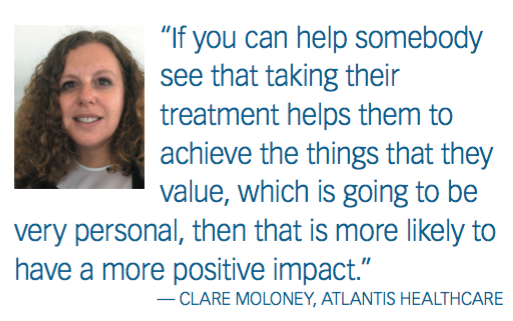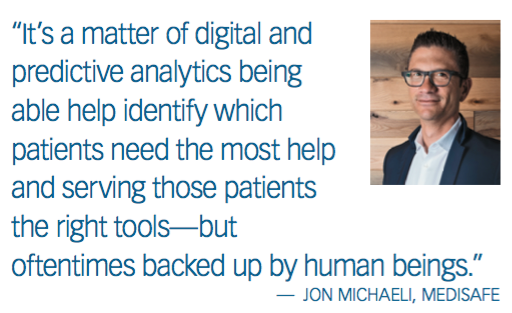Patient Insights in the Age of AI
With digital interventions in drug adherence regimes evolving to new levels of sophistication, Pharm Exec looks at the ongoing patient-behavior and privacy issues that still present significant challenges.
“One of the greatest cost drivers in healthcare is still hiding in plain sight. It’s called medication nonadherence.” So began an article in Forbes last month by Hayden Bosworth, professor of medicine, psychiatry, and nursing at Duke University Medical Center, and Prescriptions for a Healthy America’s Sloane Salzburg. The authors called for the issue to be a made “a national priority,” and reported on the recommendations by a group of experts representing patients, physicians, pharmacies, and pharma companies on how to fix the problem. Bosworth and Sloane identified the need for improved information sharing between the clinical and pharmacy setting, better integration of healthcare systems, the leveraging of new and better technologies, and better incentives for healthcare providers, plans and drug manufacturers to improve patient adherence in federal healthcare programs.
It is revealing that this call for action positions new and better technology as only part of the solution. In the field of digital health and patient adherence, one could be forgiven for thinking that the answers to the nonadherence problem lie in the advancing connectivity protocols and mobile solutions that incorporate medication reminders and encouragement, or enable the timing of medication access to be controlled. In the last few years, as Dr. Bill Byrom, senior director, product innovation, for the contract research organization ICON, points out, we have seen the emergence of:
- Medication event monitoring systems using bottle caps, refillable canisters or microcircuits incorporated into blister packaging to record medication removal events.
- Artificial intelligence solutions using in-app analysis of smartphone video imaging to identify medication swallowing events.
- Ingestible electronic tags incorporated into medication that provide a detectable signal when medication is ingested.
- Use of smart breath analysis devices to detect breath markers produced following medication ingestion.
- Use of sharps-bin detectors to identify disposal of single-use injectable medication events.
Such innovations continue apace, and their contribution to tackling nonadherence is vital. However, Bosworth reminds us that, while digital health is “definitely here, it’s just part of the toolbox.” He told Pharm Exec: “If people think of it as panacea that is going to solve everything, they will be consistently disappointed.” Clare Moloney, Atlantis Healthcare’s clinical strategy director, Europe, further explains: “There is still the thinking that if you put something in an app or on someone’s phone, or if you put a device
in someone’s home, that it is going to be a magic fix. This stems from the idea that people are not adhering

for just one or two specific reasons-i.e., they don’t understand or they forget.”
Digital platforms that remind patients to take their medication will of course play an increasing and eventually routine part in the future of healthcare provision. But forgetting to take a pill, for example, is just one problem in the nonadherence dynamic. “It’s different for every person,” says Jon Michaeli, executive vice president, marketing and business development at Medisafe. “It might not just be forgetfulness for many people; it might be down to complex treatment regimes. It might be about having the appropriate expectations for side effects, lack of support, lack of motivation, etc.”
In other words, it’s “a multi-factorial problem.” When patients are struggling with managing an illness as part of their day-to-day life, adds Moloney, “adherence is really a tiny part of that.” If, for example, patients are experiencing low moods or have had to reduce their working hours due to the progression of multiple sclerosis (MS), or simply don’t feel their treatment is working, “even the whizziest app or shiniest device that awards stars for adherence is just skimming the surface in terms of motivating patients to adhere” says Moloney.
Understanding patient behavior in the real world
So what can be done? How can even the most advanced treatment-delivery or monitoring systems begin to address the emotional complexities that define fundamental human behavior? Atlantis Healthcare designs and develops in-market patient solutions from a “belief-based behavior change approach.” Moloney explains that the company has a large team of health psychology specialists working in-house, who help the company “go beyond providing basic adherence interventions.” She explains that the company incorporates its behavioral-science expertise into its website and app content, enabling patients to “identify their values and give them the skills to challenge some of their unhelpful thinking, become better at managing their mood or their anxieties, or helping them to accept their condition a bit more.”
While no healthcare system can afford to provide a health psychologist in every hospital to talk to every patient about how to manage the psychological impact of a chronic condition, Moloney says that Atlantis “takes some of those psychological techniques and processes and makes them available to people as part of their support programs.” A common feature of Atlantis’s online interventions, for example, is a behavior-change technique module, “which takes patients through an exercise of how to appropriately weigh the pros and cons of making a health-related decision.” On the surface, this might sound quite easy, says Moloney, but it is a matter of helping people to “weigh the value of each decision and understand their health decisions in the context of their day-to-day life.”
“Value” is key here, but, for once, not in the usual health-economics context. Moloney explains: “We value health because of what it allows us to do; we don’t necessarily value health for the sake of it. We value being able to work full-time or spend quality time with the kids. It is about linking those values to adherence. If you can help somebody see that taking their treatment helps them to achieve the things that they value, which is going to be very personal, then that is more likely to have a more positive impact.”
Moloney says that Atlantis Healthcare, whose support programs tend to be for people with chronic conditions-MS, diabetes, cardiovascular disease, rare genetic diseases, and also oncology patients-has been able to target patients’ “unhelpful” beliefs at an individual level, and “see those beliefs change and improve from unhelpful to helpful as the program continues.” The result in such cases has shown a high level of adherence, says Moloney. “You can see rates of 85% or 90% persistence, which you would not see in the general population in that same group.”
But can such methods work outside control groups and smaller populations? “That’s the beauty of the technology,” says Moloney. Once health psychology is incorporated into a patient relationship management system, she says, it can then be rolled out via the technology. “When you have set up the rules and the

algorithm, you are able to deal with thousands of different profiles; in fact, this is much easier than screening patients on paper.”
Michaeli, who says Medisafe is addressing the multi-factorial adherence problem “in a robust personalized way,” agrees that these personalized solutions can be rolled out on an unprecedented scale. Like Atlantis, Medisafe offers a platform that aims to understand the unique barriers to adherence for each individual patient by studying their behavior and then personalizing the experience. While Medisafe is “approaching four million users globally,” Michaeli admits this is only “scratching the surface” in the grand scheme of things. “But we have reached a level of critical mass to show that our platform is indeed scalable-we grow about 75,000 new users a month organically,” he says.
Also like Atlantis, Medisafe has reported significantly higher levels of adherence. Michaeli points to a recent study by QuintilesIMS on Medisafe users with hyperlipidemia, hypertension, and diabetes, which provided a retrospective, six-month analysis that looked at patient script refills and correlated them to the Medisafe adherence data. Against a matched control group of non-Medisafe users suffering the same conditions and sharing otherwise similar characteristics, Medisafe users showed after six months a higher adherence of up to 20%, measured by medication possession ratio (MPR). Many patients using Medisafe’s platform have chronic conditions such as depression and anxiety, chronic pain, hypertension, diabetes, and epilepsy (although Michaeli also emphasizes that there are users who are managing more acute conditions and conditions such as cancer, HIV, and rheumatoid arthritis). As such, he says, it is “not just a case of the patient saying, ‘What can you do for me in month one or month two?’ but in six months, three years, or five years? It is about persistent, long-term, sustainable behavior change.”
The AI promise and data concerns
Michaeli explains that Medisafe is investing heavily in artificial intelligence (AI), with which it can passively acquire information about patients to help them over the longer term. “The great thing about AI is that it enables you not to over-complicate things,” he says. “You can give people the tools that are specifically relevant to them without having to clutter the interface with all the things that they, individually, are not inclined to use.” He adds the caveat, however, that, “AI doesn’t work in a vacuum. Other data sources (e.g., a person’s physical location relative to a health facility), consumer devices (IoT, wearables), and interfaces (e.g., Amazon Alexa) are available and advancing, which ‘understand’ and address other aspects of people’s interests, behavior, and situation. And there are other key pieces (e.g., involving caregivers), so it is also about interoperability and an integrated approach and the overall user experience, of which AI is a part.”
AI has of course been generating a buzz in higher profile areas of the patient adherence debate. How it can increase the ability of platforms and devices to influence a patient’s self-medication regimen and capture meaningful data for healthcare providers could see it fueling one of the greatest advances in the digital health space. inVentiv Health’s Head of Digital, Alex Brock, conveys some of the excitement around the potential for connectivity with consumer platforms, such as Amazon’s Echo smart speaker, Google’s Home, and most recently the Apple HomePod. “Things are happening at a very fast pace in this space-it’s been predicted that 40% of UK homes will have a smart speaker by 2018, and Gartner predicts that by 2020 the average person will have more conversations with virtual bots or assistants than they do with their spouse,” says Brock.
“Much has already been said about these devices’ potential application for supporting patients-setting reminders, answering questions, capturing feedback,” adds Brock. “That doesn’t mean that voice is going to be a killer app for patient support across the board, but there are certain audiences and conditions where voice-driven interfaces could make a world of difference. For example, conditions affecting the aging population, conditions that impact movement or vision. There are people who need home monitoring and alarm systems that don’t rely on reaching and pressing a button.”
According to Brock, in the UK, about 40% of the National Health Service (NHS) budget is spent on the over-65 age group. “Anything that can be done to keep people feeling secure, independent and ‘normal’ in their own home is going to be a big win for everyone,” he says.
Brock points out that devices like the Echo are already being adopted as an assistive technology by entrepreneurial patients and carers. A voice-driven conversational interface doesn’t require any manual dexterity to use it, so it’s immediately suited to people with conditions such as arthritis or Parkinson’s disease.
“For home monitoring, we’re already seeing a raft of apps (or Skills, as Amazon calls them) that allow you to connect to an emergency contact, which has obvious utility for elderly people,” Brock says. “For conditions such as Alzheimer’s or dementia, a tool like the Amazon Echo could act as an outsourced memory, able to take notes and reminders and replay them as often as needed. Even basic-use cases of managing a smart home, turning on the lights via a voice interface, can improve quality of life and help people to stay in their own homes for as long as possible. There’s been a lot of talk about the ‘healthcare internet of things,’ but now that internet of things has a voice and I think it’s going to become louder over the next few years.”
But for all the mouth-watering promise of AI, the question of data privacy remains a sticking point in the digital health debate. The problem isn’t one of technology, says Brock, it’s one of integration and interoperability. “All these government health systems are not designed to integrate with these new data generating technologies. That is where there is some tension, of course.”
Bosworth points to the recent cyberattack on the NHS, which left IT systems in chaos and hospitals unable to access electronic patient records. “Data privacy is certainly a legitimate issue,” he says. “I think we can do it in a better way. Google right now can tell you pretty much where anybody is; the genie is out of the bottle. But if you’re dealing with confidential things like HIV, we need to think it through a bit more. There are companies and places that have figured it out, but it isn’t clear. If there was one thing that could make things a bit easier, it would be some consistency in the regulations and their interpretation.”
Michaeli says, “There are people out there who are going to try and expose private information, so I wouldn’t say we are at a place where people don’t need to worry at all.” People need to understand how their data is being handled and the security procedures being followed, he adds. “But, ultimately, the benefit of using services like ours to a patient’s health and well-being is far greater than the risk.”
Patient-led patient adherence
Whether the moves to ease data privacy tensions will be effective in the coming years, digital interventions in patient treatment and adherence will continue to evolve at a rapid pace. ICON’s VP of Innovation, Dr. Willie Muehlhausen, says we will see more unobtrusive ways to monitor and understand patients’ behavior, but for this to be effective, pharma “will need to understand that patients will be more knowledgeable about treatments and will have higher expectations regarding their drug and their dosing.” It will not be good enough to have an effective drug in the market, he explains-it will also need to be easy to apply or to ingest.
“Patients will need to be seen as consumers, and consumers will have an opinion on how the ‘product’ should be designed and how it should behave,” says Muehlhausen.
As with the shift toward patient-centricity across the rest of the industry, patient involvement in improving patient adherence at a technological, cultural, and strategic level will be paramount. “We need to listen to the

patients’ feedback,” says Moloney. “Some things they need we may not be able to provide, but we can focus the research and innovation to be a bit more ‘bottom up.’”
Bosworth adds: “if we really want patient-centered care, patients should choose the mode of how they want messages.”
So, for digital adherence interventions to truly work, the technology needs to be tempered by human insight. “It comes back to balance,” says Moloney. “If everything becomes online and virtual, patients begin to miss the element of social support. It’s important that we don’t just do everything digitally; that might be cost-effective and scalable, but there is the risk that it becomes too impersonal for people who need other types of support. Digital screening is never going to be as able to asses someone’s needs in the ‘here and now’ in the same way a human being can.”
Michaeli agrees: “I don’t want to be so simplistic as to say that everything is digital, everything is mobile. It’s a matter of digital and predictive analytics being able help identify which patients need the most help and serving those patients the right content tools, resources and interventions-but oftentimes backed up by human beings.”
Julian Upton is Pharm Exec’s European and Online Editor. He can be reached at julian.upton@ubm.com

Is Artificial Intelligence a ‘Product’? Products Liability Implications for AI-Based Products
April 10th 2025As the physical products we use evolve to become increasingly complex, traditional products liability frameworks may not always fit to provide remedies for harm that can result from using novel product types.